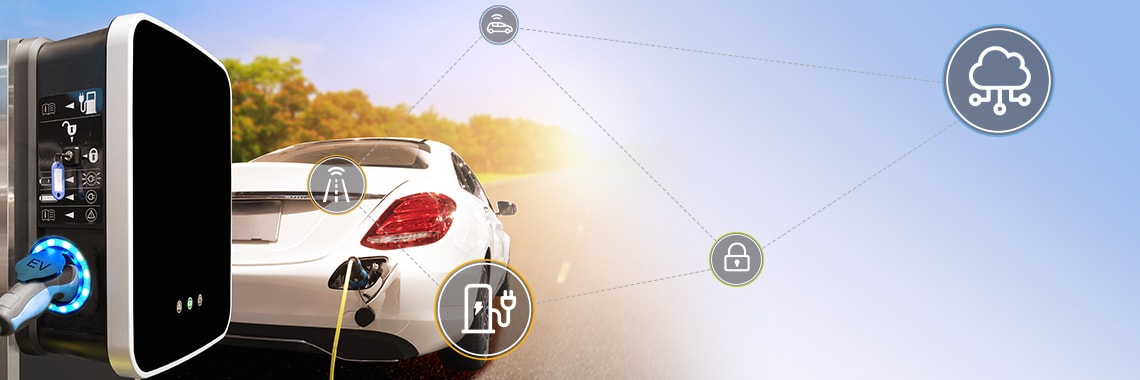NXP can help electric vehicle charging station manufacturers navigate the complex intersection of technical, functional and
regulatory requirements from varied users with vastly diverse goals.
Demands From Every Direction
To satisfy electric vehicle owners and operators, manufacturers of electric
vehicle charging stations must address demands for safety, security, accurate
power measurement and reliable financial transactions. Electric vehicle owners
and operators also benefit from easily accessible information about chargers
and power availability throughout the day. Grid operators demand real-time and
accurate energy consumption data at the point-of-use to efficiently and
effectively manage the power load. The energy supplier needs customer ID,
accurate energy consumption records and up-to-the-moment tariff and billing
info to create and deliver an order used for settlement of payment. Meanwhile,
the charge point operator requires a record and analysis of performance data
to manage their infrastructure. Finally, the EV charging station manufacturer
needs to monitor equipment health status, manage firmware updates and handle
equipment errors. Many of these requirements rest on a core need for reliable,
secure communication between the edge and the cloud.
NXP is positioned to provide solutions for each of the requirements outlined
above, and in future blogs we will delve into the details about how NXP
products help address requirements from each user or entity who interfaces
with an EV charging station. Today’s blog focuses on how NXP solutions enable
reliable and secure communication with the cloud.
Why would a manufacturer want to connect EV charging stations to the cloud?
Looking only at the initial investment, it may be less expensive and simpler
to go with a local EV charging station solution. However, cloud connectivity
presents multiple ways to increase functionality and profit. The power of the
intelligent edge and the intelligent cloud working together allows for load
balancing to avoid overwhelming the grid at peak charging times. Energy
suppliers or grid operators can adjust prices based on demand, to incentivize
electric vehicle operators to charge at lower demand times. When real-time
communication and broad data analysis are available, EV fleets can even give
power back to the grid, acting as massive batteries to mitigate periods of
high energy demand on the grid.
Answers at the Edge and in the Cloud
Cloud-connected EV charging stations give customers access to information
about where to go for a fast charge when they need it. Cloud connectivity also
enables over-the-air (OTA) updates to quickly deploy security patches or roll
out firmware upgrades, without rolling trucks to each EV charging station
location. National smart metering projects typically update every 30 minutes,
every hour or once per day. This latency is unsuitable for real-time control
of an intelligent smart grid and is thus a key driver for connectivity outside
of the smart metering infrastructure.
Looking more closely at the ownership model, a range of stakeholders include
the OEM, the charge point operator, the grid operator, the energy supplier,
etc. Each of these must be assigned correct ownership, credentials and access
during the installation phase without requiring an IT specialist to meet
defined security policies.
The scenarios described above require an optimized relationship between the
intelligent edge and intelligent cloud. The market is driving many
industries—including EV charging station manufacturers—to leverage a powerful
hybrid edge/cloud model. They expect the benefits of zero-latency processing,
which works even without a connection at the edge, as well as fleet
management, data aggregation, unlimited storage and unlimited processing
that’s available in the cloud. While manufacturers are experts in their
domains, it can be a stretch to effectively implement the required
connectivity, security and provisioning in their designs. Experience shows the
developer’s effort and risk are spent mostly on integration and
interoperability.
Leveraging Microsoft Azure Ecosystem
Being aware of these challenges, NXP partnered with Microsoft to create the
EasyEVSE EV charging station development platform. This cloud-connected development platform allows customers to accelerate
innovation and simplify the design process while integrating products from
across NXP. Customers can quickly load the Azure RTOS-based application
software on the NXP
i.MX RT1064
crossover MCU and securely connect the simulated EV charging station to
Microsoft Azure IoT Central service. The development platform features
NXP Kinetis®
metrology MCUs, which include mature reference designs, schematics and
metrology software. To support secure communication between the car, the EV
station and the cloud, the reference design shows how to leverage the
NXP EdgeLock SE050 secure element
to meet ISO15118, X.509 and IEC 61508 security and safety requirements.
Customers can use the platform as the foundation to develop a full,
differentiated EVSE system.
Unlocking IoT Business Value at the Edge
Many Ways to the Cloud
Beyond the Azure-based EasyEVSE development platform, there are many ways to
connect an EV charging station to the cloud—from cost-effective Linux and
RTOS-based industrial solutions for always-on applications running OCPP2.x, to
bare metal entry level solutions—all supported by NXP.
Access more information about how NXP enables EV charging station development
through the
EasyEVSE Development Platform.




